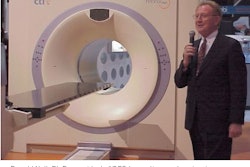CHICAGO - The latest fad in the world of mall medicine -- full-body CT screening -- provides useful information only about half the time, and even then the results are only as good as the costly follow-up care required.
Yet, some radiologists say the high-priced testing, which is not covered by insurance, is really the 21st century answer to the corner doctor.
Those conflicting opinions represent just the tip of the iceberg in a dispute that is dividing medical experts, according to Dr. Max Rosen, assistant professor of radiology at Harvard Medical School and chief operating officer/medical director at BeWell Body Scan in Boston, MA.
Full-body CT screening is widely promoted in radio and newspaper advertisements as a way to detect potential health problems -- especially cancers or heart disease -- well before symptoms appear. Critics, however, say that rather than offering a clean bill of health, the scan actually opens the door for false-positive findings and additional unnecessary tests, or even exploratory surgeries.
And in three states the controversy has resulted in new laws: New York, Pennsylvania and Texas ban walk-in full-body CT scans. “In New York, patients must have a referral from a physician,” said Dr. Hedvig Hricak, chairman of radiology at the Memorial Sloan-Kettering Cancer Center in New York City. Moreover, she said that New York law requires that “a radiologist be onsite at the CT center.”
At this week's RSNA meeting, Rosen presented a marketing survey of people living in the Boston area that assessed attitudes about full-body CT screening.
He said that 450 people who answered questions in a random telephone survey conducted in September 2001 initially had no opinion about full-body CT. “But after an explanation of what full-body CT is, 82% said they were interested in it,” Rosen said. And 72% said they liked the “idea that they could go over results with a radiologist.”
Rosen also presented additional data on 310 people who have had full-body CT at his center since it opened. He said that many people seek out full-body CT because “they are interested in making a lifestyle change and want to find out more about their own health.”
But Dr. Giovanna Casola, professor of radiology and chief of body imaging at the University of California, San Diego, said that many people who self-refer to full-body CT are looking for false assurances.
She said the full-body CT fad actually started in California three years ago and was marketed with ads that told potential clients “you owe it to your loved ones.” At that time, she said, the emphasis was on the part of the procedure that tracks calcium build-up in blood vessels in the heart. These calcium deposits are considered markers for advanced heart disease. “So men with wives and children would have the scans as a way of ‘protecting’ the family,” said Casola.
She and her colleagues analyzed the results from almost 1,200 people who had scans done by a for-profit scanning center in Southern California. She said that 54% of the people received clean bills of health, 15% had abnormal but harmless findings, 25% had possible malignancies, and 1% had findings that strongly suggested cancer.
In all, 442 patients were told they needed more tests. Most of the patients who required additional testing were older than 45, said Casola. “So, one recommendation that we can make is that full-body CT should be limited to those who are older than 45. In this series there were 22-year-olds getting scanned. That is too young, because CT scans do expose people to radiation, which itself is a risk for cancer.” Ideally people should have as few scans as possible over the course of a lifetime, she said.
But the most troubling aspect of the scans, said Casola, is that scans offered are not the most effective type of tests for detecting conditions like liver, kidney, or stomach cancer. “To detect abdominal abnormalities one needs to inject a contrast dye into the abdomen. These scans are all done without contrast,” said Casola.
Casola also criticized the lack of follow-up at most commercial scanning operations. “There is a total lack of communication with a primary care physician,” she said. Rosen said that is not the case at his center because not only does the radiologist personally review the scanning results with the patient, but the results are sent to the person’s physician. If the client has no physician, Rosen’s center arranges for primary care follow-up.
By Peggy Peck
AuntMinnie.com contributing writer
December 4, 2002
Copyright © 2002 AuntMinnie.com




















